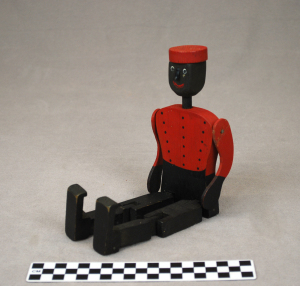This object is a limberjack doll, sometimes called a jig doll because it is designed to “dance a jig.” A limberjack doll is similar to a puppet. It is made of wood and is usually modeled after a human or animal figure. A limberjack doll features sectioned joints at the shoulder and elbows and at the hips and knees allowing the figure to move.
A limberjack doll is operated much like a rhythm instrument. First, you must sit with one end of a thin board under you, with the opposite end out in front or out to one side. While holding on to a wooden stick that is inserted in a small hole in the back of the doll, the doll is held above the board with its feet barely touching the board. Next, you lightly tap the board just behind the doll’s feet. The board will bounce gently causing the Limberjack Doll to move at the joints. These dolls provided hours of entertainment throughout Europe, the United Kingdom, and the United States.
The limberjack doll featured here is modeled after a train porter. A porter is a person who assists passengers board trains. A porter is responsible for everything from loading a passenger’s luggage onto the train to making up the beds for passengers in the sleeper cars. In the United States the Pullman Company was responsible for creating the first sleeper cars in the 1860s. As the American Civil War came to an end, the company began hiring former slaves as porters. Since many middle class people had never had any type of assistance, the Pullman Company advertised trips in their sleeper cars as an upper class experience.
The Pullman Company became one of the largest employers of African-Americans. Although having a job as a porter was considered one of the best jobs African Americans could obtain, it was also a job where African Americans had to tolerate being stereotyped and many forms of abuse. The porters were paid incredibly low wages and had to rely on tips. In addition to being paid low wages, porters were required to pay for their own uniforms, the shoe shine they used on their customers shoes, food, overnight stays on the trains, as well as having to pay for items that were stolen by passengers. Often these costs added up to almost half of the Porter’s wages. Porters worked about 400 hours a month and worked shifts were sometimes 20 consecutive hours.
Although the Porters were not involved, there was an employee strike against the Pullman Company in 1894 over reductions in pay. The strike began in Chicago where the factory was located, and affected railroads across the United States when the strike stopped all trains using Pullman cars from moving. The President of the United States, Grover Cleveland, had to step in to end the strike. He ordered the Army to stop the striking employees. The strike left an unfavorable outcome for the employees as well as the Pullman Company. The strike was also a defeat for the American Railway Union that lead to the downfall of industrial unions.
In 1918 the Order of the Sleeping Car Conductors was created however, African Americans were not allowed. As a result Asa Philip Randolph created an organization called the Brotherhood of Sleeping Car Porters. In which porters demanded better working conditions and decent wages. It wouldn’t be until 1925 that Pullman porters saw any improvements. Today many credit Pullman porters as a significant contribution to the creation of the African American middle class. In 1995 the A. Philip Randolph Pullman Porter Museum was founded. One of their projects included forming a registry of African American Railroad Employees. In 2008 Amtrak became aware of this and partnered with museum to locate and honor surviving porters.
